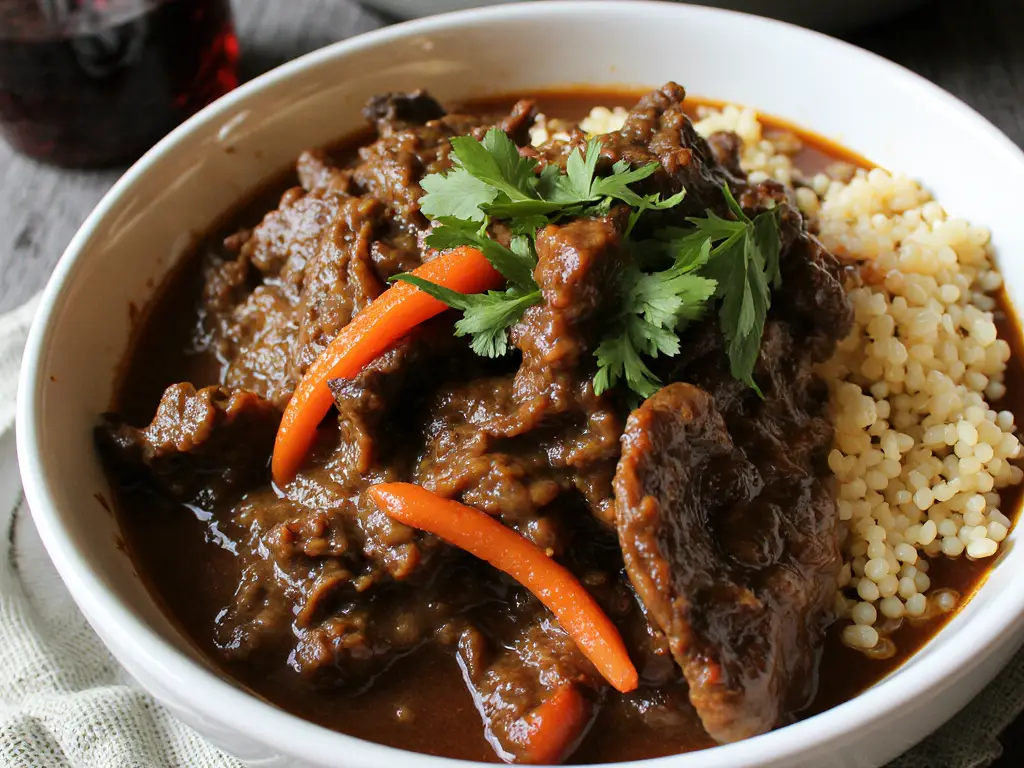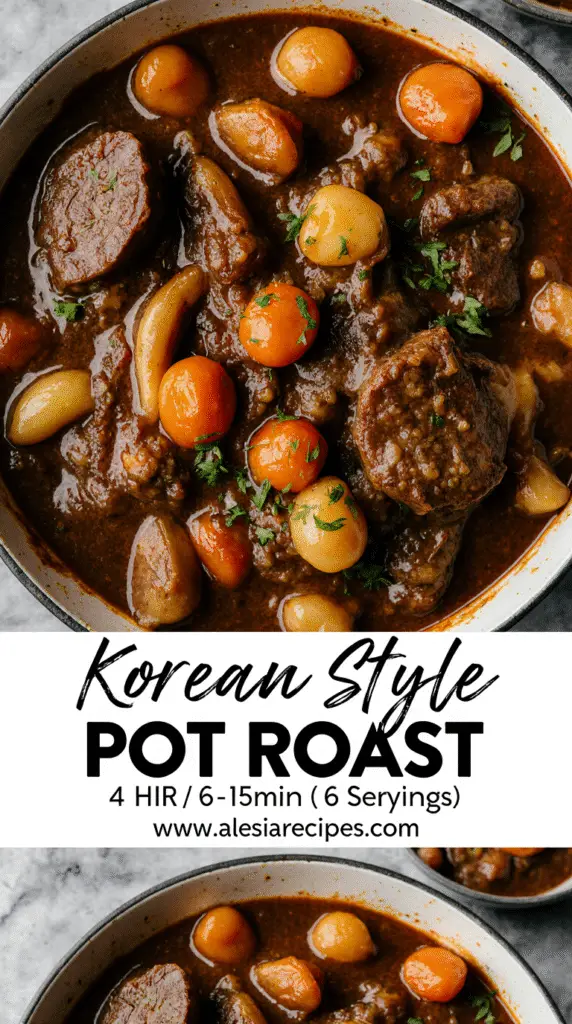How to Make Korean Chuck Roast: A Foolproof Guide for Tender Results
Korean chuck roast combines the comforting tenderness of traditional pot roast with bold, spicy Korean flavors that will awaken your taste buds. When prepared correctly, this fusion dish features tender beef swimming in a zesty sauce made with soy sauce, gochujang, and fresh ginger.
I’ve discovered that the secret to a perfect Korean beef chuck roast recipe lies in choosing the right cut. Chuck roast offers an ideal balance of muscle and fat, resulting in exceptionally tender and juicy meat. Not only is it affordable, but it also transforms beautifully during slow cooking.
Instead of traditional potatoes typically served with American-style pot roast, we recommend serving this Korean chuck roast over sticky rice. The combination creates the perfect vessel for soaking up all that rich, spicy sauce. Best of all, this dish captures all the fantastic flavors of Korean BBQ using ingredients you can find at most grocery stores.
Whether you prefer using your slow cooker, Instant Pot, or traditional oven-braising method, I’ll guide you through creating this mouthwatering dish step by step. Let’s dive into making a Korean chuck roast that will become a new family favorite!
Choose the Right Cut of Beef
Selecting the perfect cut of meat forms the foundation for a delicious Korean chuck roast. The right beef cut will determine how tender, juicy, and flavorful your final dish turns out.
Why chuck roast works best
Chuck roast comes from the forequarter—specifically the neck, shoulder blade, and upper arm areas of the cow. This working muscle area develops excellent flavor while maintaining the ideal balance of meat and fat for slow cooking.
For Korean chuck roast, this cut excels primarily due to its generous marbling. The fat in chuck roast is distributed between the muscles, which melts during cooking and essentially self-marinates the meat from within. This creates that melt-in-your-mouth texture we crave in Korean beef dishes.
Furthermore, chuck roast contains beneficial connective tissue that, when cooked properly, breaks down and adds body to both the meat and the braising sauce. The cut’s rich, beefy flavor stands up beautifully to the bold Korean seasonings, making it perfect for dishes where robust flavor is desired.
How to spot good marbling
Marbling refers to the thin threads of intramuscular fat interspersed within beef between muscle fibers. When examining chuck roast for your Korean recipe, look for:
- Fine marbling with thin fat flecks evenly distributed throughout the lean muscle
- A firm feel and pure white color of the fat when chilled
- A swirled pattern of marbling rather than large, uneven chunks of fat
Quality marbling is crucial because during cooking, it melts and adds a buttery flavor and juiciness to the meat. The marbling keeps the meat moist, preventing natural juices from evaporating. Consequently, your Korean chuck roast will remain tender even after hours of cooking.
Can you use brisket or other cuts?
While chuck roast provides exceptional results, brisket certainly works as an alternative for Korean-style roasts. However, there are key differences to consider.
In contrast to chuck roast, brisket comes from the breast and lower chest area of the cow. It tends to have less marbling throughout, with fat content mostly limited to the exterior. Due to this difference, brisket needs an even longer cooking time than chuck roast to reach the same tenderness.
For those seeking other options, beef oyster blade (flatiron steak in the US) can work well in Korean recipes as it has similar cooking and flavor characteristics to beef short ribs. Traditional Korean cooking sometimes uses boneless beef ribs or other thinly sliced cuts, though these may be harder to find outside of specialty Asian markets.
Regardless of your choice, remember that cuts with good marbling and connective tissue will deliver the most satisfying results for your Korean chuck roast recipe.
Build the Korean Flavor Base
The authentic flavor of Korean chuck roast emerges from a harmonious blend of traditional Korean ingredients that create its signature taste profile. Creating this distinct flavor base requires understanding a few key components and how they interact.
Essential ingredients: gochujang, soy sauce, garlic
First and foremost, gochujang stands as the backbone of Korean cuisine. This thick, fermented red chili paste brings a complex blend of spiciness, umami, and subtle sweetness from its months-long fermentation of chili peppers, soybeans, and rice. As a staple in Korean cooking, gochujang delivers a healthy amount of lingering heat with subtle sweetness and depth.
Soy sauce contributes the essential savory umami foundation to your Korean chuck roast. It provides deep, rich flavor that complements the beef perfectly. For best results, many recipes recommend low-sodium varieties to maintain better control over the final saltiness.
Garlic plays an indispensable role in Korean flavor profiles. Korean recipes often call for generous amounts—typically 4-10 cloves for a single roast. This isn’t excessive; moreover, the garlic melds beautifully with other ingredients during slow cooking without overpowering the dish.
Balancing heat and sweetness
The magic of Korean chuck roast lies in balancing spicy heat with sweetness. Brown sugar (either light or dark) is typically added in amounts ranging from 1-3 tablespoons to counteract the heat from gochujang. Dark brown sugar delivers a deeper, more caramelized flavor profile if you prefer more richness.
In addition to sugar, some recipes incorporate Asian pear juice or puree as a natural sweetener that simultaneously tenderizes the meat. This traditional ingredient breaks down muscle fibers while adding subtle sweetness.
Optional add-ins for depth
To create even more complex flavors in your Korean chuck roast:
- Sesame oil: Use toasted varieties for their distinctive nutty, roasted flavor
- Rice vinegar: Adds brightness and acidity that cuts through the rich, fatty beef
- Fresh ginger: Works alongside garlic for aromatic depth
- Onions: Provides savory foundation (often used in multiple forms—yellow, green, or minced)
Many authentic recipes include a small amount of sesame seeds as garnish, adding visual appeal and subtle texture to the finished dish. Including these optional ingredients elevates your Korean chuck roast from good to exceptional, creating layers of flavor that develop throughout the cooking process.
Cooking Methods for Perfect Texture
Mastering the cooking technique for Korean chuck roast determines whether your dish turns out fall-apart tender or disappointingly tough. The right method transforms this economical cut into a magnificent meal, regardless of which cooking appliance you prefer.
Oven-braised Korean chuck roast
Oven-braising creates exceptional flavor through browning reactions. Preheat your oven to 325°F (165°C), sear the seasoned roast for 3-4 minutes per side in a Dutch oven, subsequently add your Korean sauce mixture, and cover tightly. Cook initially for 30 minutes, afterward reduce temperature to 300°F (150°C) for approximately 1.5 hours. Alternatively, maintain 350°F for the entire cooking time (about 2 hours total).
Korean chuck roast slow cooker method
For busy days, slow cookers offer convenience without sacrificing quality. Place your seasoned chuck roast with Korean sauce in the slow cooker and set on low for 7-8 hours or high for 3-4 hours. Nevertheless, low temperature cooking consistently produces more tender results. Upon completion, consider thickening the sauce with 1-2 tablespoons cornstarch mixed with water, then cooking an additional 30 minutes.
Korean chuck roast Instant Pot version
The Instant Pot dramatically reduces cooking time without compromising tenderness. Cook on manual/pressure cook for 40 minutes, followed by 15-25 minutes natural pressure release. Notably, it takes about 10-15 minutes to reach pressure beforehand. The entire hands-off process requires approximately 65-75 minutes—significantly faster than traditional methods yet still achieving that melt-in-your-mouth texture.
How to know when it’s done
Chuck roast is properly cooked when it reaches 195-210°F internally. Indeed, while most meats are done at lower temperatures, tough cuts like chuck roast benefit from what seems like “overcooking”. For sliceable beef, aim for 198-204°F; for easily shreddable meat, 210°F is ideal. The meat should effortlessly pull apart with minimal resistance from a fork—this is the ultimate indicator of perfectly cooked Korean chuck roast.
Serving, Storing, and Leftover Ideas
The versatility of Korean chuck roast extends beyond the initial meal, offering opportunities for enjoyable dining experiences and creative repurposing. Let’s explore how to serve, store, and reimagine this flavorful dish.
Best sides: rice, kimchi, or mashed potatoes
Primarily, steamed white rice creates the perfect foundation for Korean chuck roast, absorbing the rich sauce. Alternatively, mashed potatoes provide a comforting western twist that pairs surprisingly well with the bold Korean flavors. For an authentic experience, serve with traditional banchan (side dishes) like kimchi, which adds a fermented tang that complements the beef’s richness. Fresh options like cucumber salad with sesame oil and vinegar or stir-fried vegetables such as bok choy and snap peas round out the meal beautifully.
How to store and reheat leftovers
Store cooled Korean beef in airtight containers in the refrigerator for up to 4-5 days. For longer preservation, freeze in freezer-safe bags for up to 3 months. When reheating, prevent dryness by adding a splash of water or broth. Microwave until warmed through, stirring halfway for even heating. Alternatively, reheat in a 325°F oven with leftover sauce and additional broth if needed.
Creative ways to use leftover Korean beef chuck roast
Firstly, transform leftovers into Korean beef lettuce wraps by using Boston lettuce leaves as fresh vessels. Furthermore, repurpose the tender meat into tacos topped with slaw made from cabbage, cucumbers, and carrots. Above all, consider creating Korean fried rice by combining chopped leftover beef with cold rice, vegetables, and a touch of gochujang. The tender texture of chuck roast makes it ideal for reheating without becoming tough.
Conclusion
Korean chuck roast truly represents the best of both culinary worlds. Throughout this guide, we’ve explored how this affordable cut transforms into a magnificent dish when paired with bold Korean flavors. After trying various methods, I’ve found that chuck roast consistently delivers exceptional results because of its perfect balance of fat, connective tissue, and muscle.
The magic happens when gochujang, soy sauce, and garlic work together with your choice of sweeteners and aromatics. Therefore, don’t hesitate to adjust the heat level or sweetness according to your family’s preference. Your patience during the cooking process, whether using an oven, slow cooker, or Instant Pot, will certainly reward you with meat that practically melts in your mouth.
Equally important, this dish offers remarkable versatility beyond your initial meal. Leftover beef can become the star of creative dishes like lettuce wraps, tacos, or fried rice. The flavors actually deepen overnight, making next-day meals sometimes even more delicious than the original!
Finally, Korean chuck roast provides an accessible entry point into Korean cuisine without requiring specialty ingredients. Most grocery stores now carry everything needed to create this crowd-pleasing dish. Give this recipe a try the next time you’re looking for something different yet comforting. Your family will undoubtedly request this flavorful, tender Korean chuck roast again and again!
FAQs
Q1. What’s the key to achieving tender Korean chuck roast? The secret lies in cooking the meat low and slow. This method allows the connective tissues to break down, resulting in a melt-in-your-mouth texture. Whether using an oven, slow cooker, or Instant Pot, maintaining a low temperature for an extended period is crucial for tenderness.
Q2. How can I enhance the flavor of my Korean chuck roast? Build a flavorful base using essential Korean ingredients like gochujang (fermented red chili paste), soy sauce, and garlic. Balance the heat with sweetness by adding brown sugar or Asian pear juice. Optional add-ins like sesame oil, rice vinegar, and fresh ginger can further deepen the flavor profile.
Q3. What’s the best way to cook Korean chuck roast in a slow cooker? Place the seasoned chuck roast in the slow cooker with your Korean sauce mixture. Cook on low for 7-8 hours or on high for 3-4 hours. For best results, opt for the low-temperature setting as it consistently produces more tender meat.
Q4. How do I know when my Korean chuck roast is perfectly cooked? The ideal internal temperature for chuck roast is between 195-210°F. At this point, the meat should effortlessly pull apart with a fork. For sliceable beef, aim for 198-204°F; for easily shreddable meat, 210°F is ideal.
Q5. What are some creative ways to use leftover Korean chuck roast? Leftover Korean chuck roast is versatile. You can use it to make Korean beef lettuce wraps, transform it into flavorful tacos topped with Asian-inspired slaw, or create a delicious Korean fried rice by combining the chopped beef with cold rice, vegetables, and a touch of gochujang.


